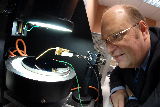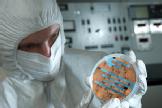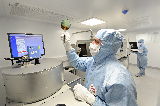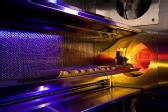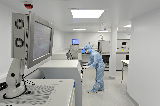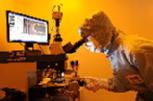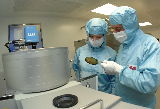Power electronics and silicon carbide
Electricity has transformed our society and quality of life. But now it is time to transform our electricity supply to achieve policy targets driven by climate change and energy security. Developments in semiconductor technology have already improved the efficiency of electrical energy conversion, but there is further potential for efficiency gains. To realize this potential, a unique semiconductor cleanroom has been established at the University of Warwick, supported by funding from Advantage West Midlands and the European Regional Development Fund as part of the Birmingham Science City Research Collaboration (SCRA).
Operational from early 2010, the specialised laboratory includes a semiconductor Class 1000 cleanroom, humidity controlled, with a yellow room for photolithography capable of one micron lithography and a suite of processing equipment. The laboratory provides for research into the materials physics and device fabrication technology of silicon carbide. It also functions as an incubator unit for development of new device concepts and prototype devices for the power electronics systems community, both academic and industrial.
Silicon carbide (SiC) offers major advantages in electronics due to its exceptional material properties. SiC is able to operate at much higher voltages and temperatures than silicon. The SiC devices enable a substantial reduction in the size and weight of power electronic modules wherever they are used because of their high power efficiency and the ability to run at higher frequencies and temperatures than Si devices. There are numerous potential applications in various sectors including: power generation, power conversion, aerospace and automotive and Smart Grid development.
The laboratory is available for use, with support of the PEATER team, by experts from academia or industry wanting to develop or test devices. The team is also looking for opportunities to collaborate with interested companies or academics, particularly from the West Midlands region.
For further information, including proposals for collaboration or access to the facilities please contact:
Business/industry contact: Mike Ahearne, Business Engagement Manager for the Birmingham Science City Energy Efficiency & Demand project.
Email: m.ahearne@warwick.ac.uk Mobile tel: +44 (0)7824 541173
All other enquiries: Mark Crouch, Power Electronics Applications and Energy Research, Electrical and Electronic Engineering Division, School of Engineering, University of Warwick, Library Road, Coventry, CV4 7AL, United Kingdom.
Tel: tbc Fax: +44 (0)2476 151294 , E-mail: M.A.Crouch@warwick.ac.uk
The processing equipment includes:
- High Temperature Furnace – a unique custom vertical design aimed at high quality Gate oxides on SiC in a new temperature regime up to 1500°C and implant annealing 100 mm wafers in Argon up to 1800°C
- A metal contact formation furnace capable of 1000°C specifically for SiC processing
- Inductively Coupled Plasma Dry Etcher – low ion energy for good mask selectivity and minimum physical damage, but high rate etching of SiC, Si, SiO2, Si3N4 using fluorinated gases
- Low Pressure SiO2 Deposition – a TEOS based system which will deposit high quality field oxides to avoid the need to grow thick oxides on SiC
- A 1:1 stepper and associated coater/developer capable of 0.75 micron lithography
- An advanced stylus based physical film thickness monitor using an optical lever from Ambios Technology and an industrial quality ellipsometer to measure the optical constants of the SiC system and optical film thickness
- A Reichart analytical microscope with a high quality CCD camera and image processing software
- Extracted solvent and acid benches for wafer cleaning and other operations
The Power Electronics Applications in Energy Research Group (PEATER) was founded in 2005 by Professor Philip Mawby, to establish a world-class centre for research into power electronics, power semiconductor devices and applications in power systems and power conversion. Professor Mawby has built an international reputation in the area of power electronics and power device research. His main interests are materials for new power devices, modelling of power devices and circuits, power integrated circuits. The area of efficient electrical energy conversion has become critical in the development of renewable energy systems, sustainable transport and many other applications. The team also includes: Dr Mike Jennings a Science City Research Alliance Fellow undertaking research into Silicon Carbide power devices; Dr Peter Ward who has had an extensive industrial career in the field of Silicon technology. This group has active industrial and academic collaborations running in the fields of Aerospace, Semiconductor Research, Automotive, Power IC development and Renewable Energy. These include: automotive companies Jaguar Land-Rover, Zytek, Prodrive, Ricardo and Lotus; in the energy sector Converteam, Areva, Rolls-Royce amd Control Techniques; in the aerospace sector GE, Goodrich, Rolls-Royce as well as device companies Semelab, Westcode, NXP and Dynex.
These facilities are based at the University of Warwick
The cleanroom was launched 2nd July 2010 - view presentations and pictures here
A brochure with details of these facilities can be downloaded here ![]()
Detailed descriptions of equipment items and their capabitlity can be downloaded here ![]()
